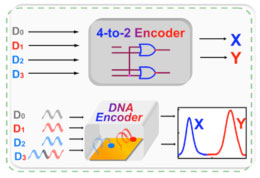多重バイオセンサーによって構成されるDNA生体分子-電子符号化・復号化デバイス
DNA biomolecular-electronic encoder and decoder devices constructed by multiplex biosensors.
2012年1月18日 NPG Asia Materials 4, e4 (2012) doi:10.1038/am.2012.1
電子デバイス:電流でDNAの有無を知らせる

Fan Xiaをはじめとする研究チームはこのたび、電気化学センサーの作製によって、生体分子情報(DNA鎖の有無)を電流に変換することに成功した。各センサーは、電極、DNA鎖、レドックスレポーター(アントラキノン、メチレンブルー、フェロセンなど)から構成されており、特定のDNA鎖が存在すると、レドックス電流変化で応答する。これらのセンサーは、異なるDNA鎖に対して異なる電流を発生させて応答するよう設計されており、センサーをさまざまな形で組み合わせることによって、一連の符号化・復号化デバイスが得られた。これまでに開発されたシステムは概して、アウトプットとして蛍光を放出するものがほとんどだったが、これに対し今回の電気化学的手法は、DNAベースのデバイスをシリコンベースの電子デバイスにさらに一歩近づけるものであり、DNAベースのデータ処理装置の構成要素となるかもしれない。
Electronic devices: Current affairs with DNA
Fan Xia and co-workers have converted biomolecular information – the presence or absence of DNA strands – into electronic currents by assembling electrochemical sensors. Each sensor is composed of an electrode, a DNA strand and a redox reporter – such as anthraquinone, methylene blue or ferrocene – and responds to the presence of one particular DNA strand by a change in its redox current. A set of sensors were designed to respond to different DNA strands by emitting distinct currents, and combining these sensors in various ways led to a series of encoding and decoding devices. While systems previously developed had typically given fluorescent outputs, this electrochemical approach moves DNA-based devices a step closer to their silicon-based electronic counterparts, and could potentially become components in DNA-based data processors.

